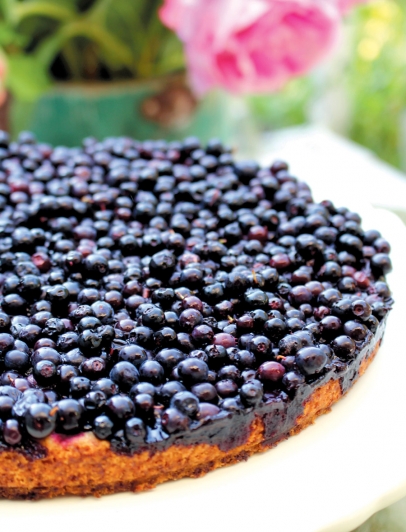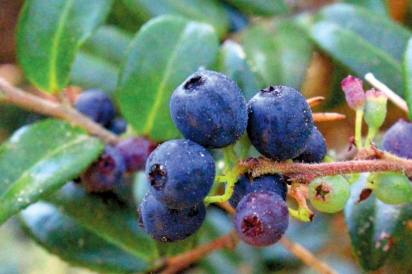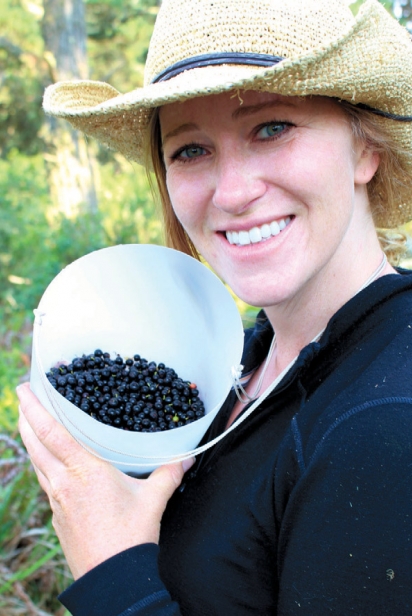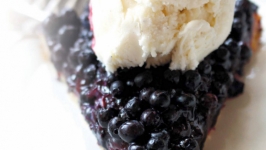Huckleberry Heaven
HEAD TO THE HILLS FOR A SLICE OF YOUR OWN
When the late summer sun heats up the coastal hills of Northern California, wild berries of all varieties reach their peak of ripeness. As a general rule, mid- to late- August is the time to grab your basket and head out to forage for one of my personal favorites: huckleberries. Small, round and varying in hue from reddish (not quite ripe) to a deep purple-black (ready to eat), huckleberries closely resemble miniature blueberries. Their delicious sweet-tart flavor has long been prized by bakers and jam makers.
Closely related with many shared characteristics, huckleberries and blueberries are often confused. Both are native to North America, but the evergreen huckleberry (Vaccinium ovatum), also known as the California huckleberry, is found only in California and the Pacific Northwest.
Huckleberry bushes, or “shrubs,” generally grow one to six feet tall, but may reach 10 feet if shaded by large trees (too much shade, however, inhibits berry development). In spring, the shrubs are covered in clusters of tiny pink bell-shaped flowers that transform into the vibrant purple berries.
Searching for huckleberries is akin to a treasure hunt, and a little forethought goes a long way to prepare hopeful seekers for success.
First-time foragers should carry a botanical field guide for identification, as there are look-alikes that should not be eaten (poisonous nightshade and pokeberries, to name two). The telltale sign of an edible berry is the tiny flared crown at the tip, the same that you find on a blueberry, which is unique to the genus Vaccinium.
A thin pair of gloves will keep hands free of berry juice stains, and shield against pokes and scratches. While huckleberry bushes are thornless, they often grow among blackberry thickets.
Proper attire also includes long pants and sleeves (to protect against poison oak) and a sturdy pair of hiking shoes. A container that can be worn around the neck to hold the harvest while leaving both hands free for picking is especially useful. This can be easily fashioned using a recycled plastic milk carton and some long shoelaces.
A fruitful forage will depend largely on good timing. Start looking too early in the season and the object of your desire may not be ripe, but wait too long and you’ll likely find branches stripped clean by birds and other critters who beat you to the harvest.
It also helps to have an adventurous mindset and loads of patience— especially patience. The tiny size of these berries makes collecting them tedious, and you need a sizeable quantity to make most recipes. As with most things in life, however, those willing to invest the time will reap the rewards.
My friend Elizabeth Hill, the owner of West Marin Food & Farm tours, is “in the know” when it comes to foraging for local huckleberries, and she kindly let me tag along on a hunt last summer—under strict orders not to share her favorite spots!
A seasoned expert, Elizabeth was well prepared for every eventuality on our foraging adventure. When we found a cache of ripe berries too high to reach, she deftly pulled a metal clothes hanger from her daypack that served as the perfect assist for hooking branches and pulling them closer. Clearly this was not her first rodeo. I made a mental note for future forages.
Soft plunking sounds were music to our ears as we slowly filled the buckets hung around our necks. Of course, I had to taste a few for “quality control” as I went along. They were warm with a sweet-tangy acidity that burst with flavor in my mouth.
As we picked, Elizabeth shared that one of her fondest childhood memories was of summers spent exploring the local hills, picking wild huckleberries that her Grandma Norma would transform into delicious tarts. My appetite piqued, I had to ask Elizabeth for yet another favor: her grandmother’s recipe!
Visions of my first huckleberry tart baking in the oven helped fortify my resolve for the task at hand. Still, it took roughly three hours before we had picked enough berries to meet our needs.
The work continued when I got home. In my haste to pick as quickly as possible, I left the tiny stems intact, which needed to be removed by hand before baking. I also managed to collect a fair amount of leaves and pine needles in my bucket that had to be sorted out. It was a meticulous process that took an extra hour. Another note to self: Better picking etiquette in the field saves considerable time on the back end.
Ultimately, the final result was well worth the eff ort. The sweet-tart essence of my hard-earned harvest was showcased beautifully in Grandma Norma’s Wild Huckleberry Tart. Crowned with a scoop of best-quality vanilla bean ice cream, it’s an exquisite summer indulgence made all the better if you picked the berries yourself.









